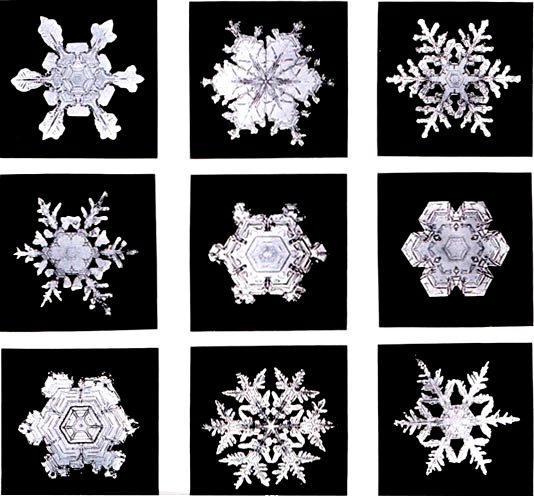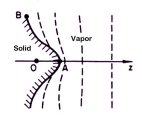
Symmetry of Snowflakes




surface bump...................dendrite ...........complex
snowflake
One thing you notice right away about snow crystals is that
they form some elaborate and complex shapes -- often displaying
lacy, branching structures. Where does this complexity come
from? After all, snow crystals are nothing more than ice
which has condensed from water vapor. How does the simple
act of water vapor freezing into ice produce such intricate
designs?
The answers to these
questions lie in just how water molecules travel through the air
to condense onto a growing snow crystal. The water
molecules have to diffuse through the air to reach the
crystal, and this diffusion slows their growth. The farther
water molecules have to diffuse through the air, the longer it
takes them to reach the growing crystal.
So consider a flat ice surface that is growing in
the air. If a small bump happens to appear on the surface,
then the bump sticks out a bit farther than the rest of the
crystal. This means water molecules from afar can reach the
bump a bit quicker than they can reach the rest of the crystal,
because they don't have to diffuse quite as far.
With more water molecules reaching the bump, the
bump grows faster. In a short time, the bump sticks out
even farther than it did before, and so it grows even
faster. We call this a branching instability --
small bumps develop into large branches, and bumps on the
branches become sidebranches. Complexity is born.
This instability is a major player in producing the complex
shapes of snow crystals.And since the ambient atmospheric
conditions are nearly identical across the crystal, all six
budding arms grow at roughly the same rate.
The temperature seen by the snow crystal is not
constant in time, however, since the crystal is being blown about
and is thus carried over great distances in a cloud. But
the crystal growth rates depend strongly on
temperature. Thus the six arms of the snow crystals each
change their growth with time, reflecting the ever-changing
conditions in the cloud. And because each arm sees the same
conditions, each arms grows the same way.
When the branching
instability applies itself over and over again to a growing snow
crystal, the result is called an ice dendrite.
The word dendrite means "tree-like," and stellar
dendrite snow crystals are common.
We can change diffusion in the lab and see how
dendrites change. If one grows snow crystals in air below
atmospheric pressure, they have fewer branches. This is
because diffusion doesn't limit the growth so much at lower air
pressures, so the branching instability is not so strong.
At higher pressures, more branches appear.
The growth of snow
crystals depends on a balance between faceting and branching.
Faceting tends to make simple flat surfaces, while branching
tends to make more complex structures. The interplay
between faceting and branching is a delicate one, depending
strongly on things like temperature and humidity. This
means snow crystals can grow in many different ways, resulting in
the great diversity we see in snow crystal forms.
So that's the story. The intricate shape of a
single arm is determined by the ever-changing conditions
experienced by the crystal as it falls. Because each arm
experiences the same conditions, however, the arms tend to look
alike. The end result is a large-scale, complex, six-fold
symmetric snow crystal. And since snow crystals all follow
slightly different paths through the clouds, individual crystals
all tend to all look different.